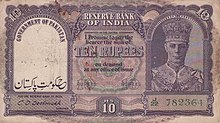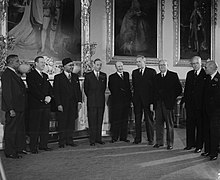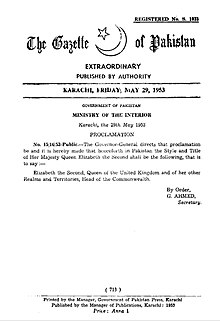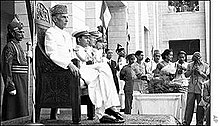Monarchy of Pakistan
He told the Pakistani people to be "assured always of my sympathy and support as I watch your continuing efforts to advance the cause of humanity".Mohammad Ali Jinnah took the following oath of office:[5] "I, Mohammad Ali Jinnah, do solemnly affirm true faith and allegiance to the Constitution of Pakistan as by law established and that I will be faithful to His Majesty King George VI, in the office of governor general of Pakistan.[6] The King confirmed the appointment of Sir Khwaja Nazimuddin as the next governor-general by a Royal decree which said:[7] "On the advice of the Prime Minister of Pakistan, His Majesty the King is pleased to appoint Khwaja Nazimuddin as acting governor-general of Pakistan in the vacancy occasioned by the sad demise of Quaid-e-Azam Mohammad Ali Jinnah.On 15 February, the day of the funeral, a national two minutes' silence was observed throughout Pakistan, and a salute of 56 guns was fired, one for each year of the King's life.[9][10][11] In the Constituent Assembly of Pakistan, the Dominion's federal legislature, Prime Minister Sir Khawaja Nazimuddin said that the King's reign will always be remembered by Pakistanis as "the period during which the Muslims of the Indo-Pakistan Subcontinent carved out a homeland for themselves".[12] Following George VI's death on 6 February 1952, his elder daughter Princess Elizabeth became the new monarch of Pakistan.[18] The Queen's coronation gown was embroidered with the floral emblems of each Commonwealth nation, and it featured the three emblems of Pakistan: wheat, in oat-shaped diamante and fronds of golden crystal; cotton, made in silver with leaves of green silk; and jute, embroidered in green silk and golden thread.Prime Minister Bogra justified the expenditure by saying that Pakistan being a member of the Commonwealth "has to fall in line with other sister Dominions on such occasions".Citing this incident, Akhilesh Pillalamarri of The Diplomat wrote that "She deliberately kept from interfering in the country and her governors-general were presidents of Pakistan in all but name.[37] The Queen visited Pakistan as Head of the Commonwealth in 1961 and 1997, accompanied by Prince Philip, Duke of Edinburgh.It was agreed at the Commonwealth Economic Conference in London in December 1952 that each of the Queen's realms, including Pakistan, could adopt its own royal titles for the monarch.The title "Defender of the Faith" reflected the Sovereign's position as the supreme governor of the Church of England, who is thus formally superior to the archbishop of Canterbury.The Hall also contains a throne which was made for King Edward VII during his tour of India as Prince of Wales in 1876, and was also used by Queen Mary during the Delhi Durbar in 1911.





Princely states of PakistanCoat of arms of PakistanElizabeth IIHis MajestyHer MajestyGeorge VIDominion of PakistanCommonwealth of NationsUnited KingdomDominionsgovernor-general of PakistanIndian Independence Act 1947dividedBritish Indiarepublic within the Commonwealthpresidenthead of stateKing George VIMohammad Ali JinnahLiaquat Ali KhanPrime Minister of Pakistan1949 Commonwealth Prime Ministers' ConferencetuberculosisSir Khwaja NazimuddinSir Ghulam MohammedConstituent Assembly of Pakistantheir conferenceSir Khawaja NazimuddinPrincess Elizabethproclaimed Queen21-gun saluteThe Queen's coronation gownher coronationCoronationQueen's coronation gownCommonwealth nationMirza Abol Hassan IspahaniHMPS ZulfiqarHMPS JhelumCoronation Review of the fleetSpitheadMohammad Ali BograCommonwealth Prime Ministers' ConferenceGovernor-GeneralSir Ghulam MuhammadEast PakistanThe Diplomat1955 Commonwealth Prime Ministers' ConferenceMajor-GeneralIskander MirzaRoyal sign-manualrepublican constitution23 March 1956republic within the Commonwealth of Nationsnew presidentHead of the CommonwealthPrince Philip, Duke of EdinburghBangladeshsuspended from the CommonwealthNazir AhmedChittagongDuchess of CambridgeQueen's realmsby the Grace of GodDefender of the Faithsupreme governor of the Church of Englandarchbishop of Canterburyrealmsministers of the CrownRoyal assentDominionMuhammad Ali Jinnahproroguingdissolvingletters of recallindictablecommon lawmonarch cannot be prosecutedGovernor-General's HouseKarachiKing Edward VIIPrince of WalesQueen Maryfount of honour1953 Coronation HonoursPakistan Defence ForcePakistan NavyPakistan Air ForceRoyal Pakistan NavyRoyal Pakistan Air ForceSt Edward's CrownTudor CrownPakistan Medalroyal cypherBaluch RegimentPakistan ArmyElizabeth Bowes-LyonWindsorPhilip MountbattenChaudhry Muhammad AliList of heads of state of PakistanList of sovereign states headed by Elizabeth IIList of prime ministers of George VIList of prime ministers of Elizabeth IIList of Commonwealth visits made by Elizabeth IIList of the last monarchs in AsiaYouTubeThe London GazetteWheare, K.C.Halsbury's Laws of EnglandHeads of statePakistanPresident (from 1956)A. KhanY. KhanBhuttoChaudhryG. KhanSajjadLeghariMusharrafSoomroZardariHussainCommonwealth realmsAntigua and Barbuda